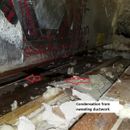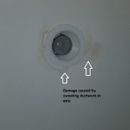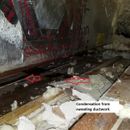Possible to use Vented attic in conjunction with Open cell spray foam?
Hello there,
I am a General Contractor in Miami, FL (Hot and humid weather!) and I may get screamed at for asking this question, but is it possible to use continuous ventilation at the soffits (vented attic) in conjunction with Open cell spray foam (sprayed to the underside of the roof sheathing)?
We removed the wet/sweating R-30 batts insulation on an poorly vented attic and installed open cell spray foam, sprayed to the underside of the roof sheathing. The problem is that the attic has become extremely moist (don’t have a reading currently) to the point that the ductwork sweats (grilles and in attic) so badly that the drywall ceiling and paint are water damaged and peelling. The smell of moisture is quite pronounced on hot and sunny days. We cant seem to find a solution to mitigate the moisture other than:
1. Add a dehumidifier in the attic space
2. Add forced Air Conditioning in the attic space as suggested by some Building Science Engineers
or 3. Cut open the soffits and add continuous ventilation which would be the easiest and probably the cheapest solution.
Granted, the attic will not be airtight but maybe it will fix the moisture problem. Am I crazy to suggest this??
Thank you in advance for your insight and comments!
GBA Detail Library
A collection of one thousand construction details organized by climate and house part












Replies
5221Lefty,
Here is an article on why you should not install open cell foam against roof sheathing (particularly in a hot, moist climate). https://www.greenbuildingadvisor.com/blogs/dept/musings/open-cell-spray-foam-and-damp-roof-sheathing
Others may post on the best steps for remediating this issue. At least open cell is easier to remove than closed cell.
Choose solution #2. In most cases installing even small registers to only semi-condition the attic space will dramatically reduce the amount of diurnal humidity pumping that is going on by actively removing the moisture with the air conditioning, and replacing it with much drier fully conditioned air, which is MUCH drier than outdoor air in SoFL during the cooling season!
In your climate venting attics to the outdoors usually adds more moisture to the attic than it removes.
Doing it with a dehumidifier (solution #1) converts the heat of vaporization of the attic humidity into sensible heat, without removing that heat. The higher attic temp makes the dehumidifier less efficient, and raises the sensible cooling load for the rooms below. Doing it all with the central air will almost always use less energy, and provide better comfort.
Installing a "smart" vapor retarder such as Intello Plus between the foam and the attic would also make a difference. How complicated that is to execute depends on the attic. Solution #2 is both cheaper to install, and more reliable.
Thanks Steve for your reply, I already have the open cell installed and would like to first try and find a solution leaving the removal of the open cell as a last resort. I had already seen that article which made my heart sink!
Thanks for your reply Dana, I wasn't aware of the issues relating to the dehumidifiers so that is good to know. Is it necessary to add return air as well?
Don't outside vent this "conditioned" attic. Lstiburek suggests 50 cfm of supply air from the HVAC system per 1,000 square foot of sealed attic. Would also be wise to install a humidity monitor (preferably with dew point display) to verify that this is always sufficient. I suspect that you will need attic (and house interior) dehumidification when the AC isn't being used.
Return air would create code/fire issues and the CFM needed won't cause much pressure differential.
Lefty,
Jon R pinpointed the real issue: You don't want to vent this type of attic (especially in Florida!). The only reason to install spray foam against the underside of the roof sheathing is if you are creating an unvented conditioned attic. You don't want to invite any outdoor air into your conditioned space.
In Florida, outdoor air is almost always hot and humid. So seal up those vents -- right away. You want your attic to be as airtight as possible.
The secondary issue is that you chose the wrong type of spray foam for this job. Anyone interested in creating an unvented conditioned attic should know that closed-cell spray foam is less likely to be associated with moisture problems than open-cell spray foam. In addition to the article mentioned by Steve Knapp (Open-Cell Spray Foam and Damp Roof Sheathing), you may want to read this article: High Humidity in Unvented Conditioned Attics.